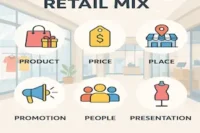What Is Retail Calendar? How to Use and Key Pros & Cons
Published: 11 Apr 2025
A retail calendar is like a key tool helping retailers set their businesses’ most crucial activities, especially promotions, sales events, and inventory management throughout the year.
It gives a clear view of what’s coming next, so you don’t miss essential shopping seasons or rush into last-minute decisions.
Here’s what a retail calendar is, why it’s important, and its key pros and cons, especially for a businessman.
So let’s come and understand it deeply.
What Is a Retail Calendar?

A retail calendar is a specialized schedule consisting of 52-53 weeks divided into months and helping store owners plan their business activities across the year.
It shows the best times to run sales, prepare for holidays, and manage stock levels.
Unlike a regular calendar, a retail calendar focuses on shopping seasons, key sale events, and how customers shop during different months.
Retailers use it to stay ahead.
For example, it reminds them to get ready for Valentine’s Day in February or Black Friday in November.
It also helps them plan promotions, order inventory on time, and make sure their team is ready for busy days.
In short, a retail calendar is a schedule of weeks and months that helps a businessman keep his store on track, organized, and ready for every season.
Key Parts of a Retail Calendar.
The key parts of a retail calendar include;
- 52 or 53 Weeks: The calendar is based on full weeks, not months, making planning and comparison easier.
- 4-5-4 Format: Each quarter follows a 4-week, 5-week, 4-week pattern to keep weekdays consistent across years.
- Quarters: The year is divided into four quarters to help retailers track seasonal performance and plan accordingly.
- Sales Events and Holidays: Includes major shopping dates like Valentine’s Day, Back-to-School, Black Friday, and Christmas.
- Seasonal Periods: Highlights key retail seasons like spring clearance, summer sales, or holiday rush.
- Week Numbers: Each week is labeled (Week 1, Week 2, etc.) to make tracking and comparison simple.
- Fiscal Year Start Date: Often starts in February instead of January to align better with retail activity after the holiday season.
- Planning Periods: Used to schedule promotions, inventory, and staffing in advance.
- Comparison Weeks: Helps compare performance with the same week in past years to track growth or decline.
How Retail Calendar Works
A retail calendar works by dividing the year into 52 or 53 weeks instead of using standard calendar months.
The most common format is called the 4-5-4 calendar, where each quarter is split into three months—the first month with 4 weeks, the second month with 5 weeks, and then the third month with 4 weeks again.
This pattern makes it easy to compare weekly and yearly sales since each period always has the same number of days and falls on the same weekdays every year.
Retailers use this calendar to plan promotions, sales events, inventory orders, and staff schedules.
It includes key shopping seasons like Valentine’s Day, Back-to-School, Black Friday, and Christmas.
Because it aligns with how customers shop, it helps businesses prepare early, avoid last-minute decisions, and stay consistent.
By sticking to this schedule, retailers can track performance, manage stock better, and boost profits.
The Key Advantages of a Retail Calendar

A retail calendar helps retailers stay organized, plan, and make smarter business decisions throughout the year.
- It helps you plan sales and promotions ahead of time
- Makes it easy to compare sales from year to year
- Keeps important shopping events organized
- Supports better inventory planning
- Reduces last-minute decision-making
- Helps you schedule staff during busy weeks
- Keeps your marketing and operations in sync
- Gives you a clear view of the retail year
- Improves store performance with better planning
- Helps you stay prepared for seasonal trends
The Key Disadvantages of a Retail Calendar

A retail calendar is helpful, but it also comes with a few challenges that store owners should understand before using it.
- It can be confusing at first for beginners to understand
- Does not follow regular calendar months, which may cause date mismatches
- Requires extra effort to align marketing and finance teams
- Needs regular updates to match new sales trends or holidays
- Comparing retail calendar data with regular calendar dates can be tricky
- May not fit well for businesses with custom or non-seasonal sales cycles
- Planning based only on retail weeks might ignore real-time customer behavior
How to Use a Retail Calendar for Your Store?
A retail calendar optimizes store operations by dividing the year into 52-53 weeks (typically in a 4-5-4 format) rather than traditional months, enabling precise planning.
Start by marking key sales events like Black Friday and back-to-school seasons, then align inventory orders 8-12 weeks in advance to meet demand.
Schedule promotions and marketing campaigns around high-traffic retail weeks, adjusting staff schedules to match anticipated foot traffic.
Regularly compare performance using year-over-year retail week data (e.g., Week 45 vs. prior year) to identify trends and refine strategies.
This structured approach minimizes last-minute decisions, prevents stockouts, and maximizes sales opportunities throughout the year.
Hey, My Dears.
So today we’ve understood what a retail calendar is in detail—from its unique 4-5-4 week structure to how it helps businesses plan sales, inventory, and staffing like a pro.
By now, you know it’s not just a calendar but a powerful tool to stay ahead of seasons, avoid last-minute chaos, and boost profits all year round.
Whether you’re prepping for Black Friday or planning summer promotions, a retail calendar keeps you organized and ready for every opportunity.
Start using one today, and watch your store run smoother than ever!
Until the Next day, keep selling smartly.

- Be Respectful
- Stay Relevant
- Stay Positive
- True Feedback
- Encourage Discussion
- Avoid Spamming
- No Fake News
- Don't Copy-Paste
- No Personal Attacks



- Be Respectful
- Stay Relevant
- Stay Positive
- True Feedback
- Encourage Discussion
- Avoid Spamming
- No Fake News
- Don't Copy-Paste
- No Personal Attacks



